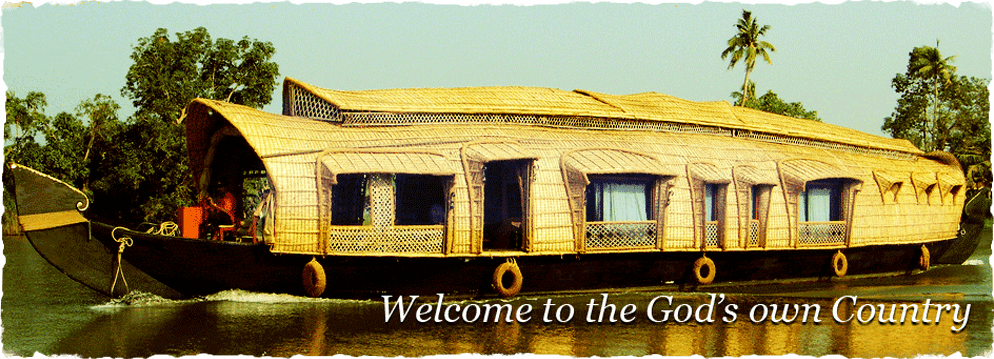
Kerala tourist destination
Kerala is a travel destination that one would not want to miss in his / her lifetime. The reasons can be many. Those who have visited Kerala, they eagerly look forward to their next. And for those who have not, can easily find a reason or two, from the many presented here.
Fort Kochi
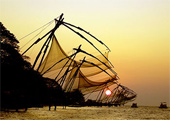
To explore the historic town of Fort Kochi, there is no better choice than setting out on foot. Relax, breathe deep and come out in cotton dresses, soft shoes and yes - a straw hat. At each and every nook of this island steeped in history, there is something amusing awaiting you. It is a world of its own, retaining the specimens of a bygone era and still proud of those days. If you can smell the past, nothing can stop you from walking through these streets.
Location: About 13 km from Ernakulam town.
Walking straight through the K. J. Herschel Road and turning left, you can have a glimpse of Fort Immanuel. This bastion once belonged to the Portuguese and is a symbol of the strategic alliance which existed between the Maharaja of Cochin and the Monarch of Portugal, after whom the fort is named. This fort was built in 1503 and reinforced in 1538. Walking a bit further, you come across the Dutch cemetery. Consecrated in 1724 and managed by the Church of South India, the tomb stones here silently remind visitors of those Europeans who left their homeland to expand their colonial empires.
The next spot to watch is the ancient Thakur House, which stands erect as a concrete specimen of the colonial era. The building is simply graceful. Formerly known as Kunal or Hill Bungalow, it was home to the managers of the National Bank of India during the British rule. Now, it belongs to the Thakur and Company, renowned tea trading firm. Walk on and there is another colonial structure awaiting you - David Hall. It was built around 1695 by the Dutch East India Company. The hall is associated with Hendrik Adriaan van Reed tot Drakeston, renowned Dutch commander, who is more admired for his monumental book on the flora of Kerala namely Hortus Malabaricus. However, David Hall is named after David Koder, a later occupant of the hall.
Walking past the Parade Ground, the four acres of ground where the Portuguese, the Dutch and the British had once conducted military parades, you reach the St. Francis Church, the oldest European church in India. It has passed through many phases ever since the Portuguese built it in 1503. Now the church is under the Church of South India. By the way, it was in this church that Vasco-da Gama had been buried and his tombstone can still be seen. The Church Road is a nice place to walk, with the cool breeze from the Arabian Sea caressing your body. Walk down a bit closer to the sea and there is the Cochin Club, home to an impressive library and collection of sporting trophies. Set in a beautifully landscaped park, the club still retains its British ambience.
Walking back to the Church Road, on the left side, you would stumble across another majestic mansion, the Bastion Bungalow. This wonderful structure of Indo-European style had been built in 1667 and is named after its location on the site of the Stromberg Bastion of the old Dutch fort. Now it is the official residence of the Sub Collector. The Vasco-da Gama square is nearby. A narrow promenade, this is an ideal place to relax a little. Stalls full of delicious seafood and tender coconuts are simply tempting. Savour a bit and feed your eyes on the Chinese fishing nets, being raised and lowered. These nets had been erected here between AD 1350 and 1450 by the traders from the court of Kublai Khan.
Refreshed, you can now proceed to the Pierce Leslie Bungalow, a charming mansion, which once had been the office of Pierce Leslie and Co., coffee merchants of yesteryears. This building reflects Portuguese, Dutch and local influences. Its waterfront verandahs are an added attraction. Turning right, you come to the Old Harbour House, built in 1808 and owned by Carriet Moran and Co, renowned tea brokers. Nearby is the Koder House, the magnificent building constructed by Samuel S. Koder of the Cochin Electric Company in 1808. This structure shows the transition from colonial to Indo-European architecture.
Turn further right and you reach the Princess Street. Mind having some fresh flowers from the shops here. One of the earliest streets of the area, this road has European style residences on both its sides. Located here is the Loafer's Corner, the traditional hangout for the jovial and fun loving people of Kochi. Walking northwards from the Loafer's corner, you come across Santa Cruz Basilica, the historic church built by the Portuguese and elevated to a cathedral by Pope Paul IV in 1558. In 1984, Pope John Paul II declared it as a Basilica. After having a quick look at the Burgher street and the Delta Study, a heritage bungalow built in the year 1808 and now functioning as a high school, you walk down, once again to the Princess Street and then to the Rose Street. There you would find Vasco house, believed to be the residence of Vasco-da Gama. This traditional and typical European house is one of the oldest of Portuguese residences in Kochi.
Turning left, you walk over to the Ridsdale Road to find the VOC gate, the large wooden gate facing the Parade ground. The gate, built in 1740, gets its name from the monogram (VOC) of the Dutch East India Company on it. Close by is the United Club, once one of the four elite clubs of the British in Kochi. Now, it serves as a classroom for the nearby St. Francis Primary School. Walking straight, you reach the end of the road and there is the Bishop's house, built in the year of 1506. It had once been the residence of the Portuguese Governor and is set on a small hillock near the Parade Ground. The facade of the house has large Gothic arches and the building was acquired by Dom Jos Gomes Ferreira, the 27th Bishop of the Diocese of Cochin whose jurisdiction extended over Burma, Malaya and Ceylon apart from India.
Yes, now it is time to wind up the walk. With the feel of the bygone days still lingering in your minds, mesmerizing sights staying back in your eyes and your taste buds yearning again for the delicacies and it is not at all a sin, if you feel like another walk!
Alleppey
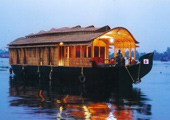
Referred to as the Venice of the East, Alappuzha has always enjoyed an important place in the maritime history of Kerala. Today, it is famous for its boat races, backwater holidays, beaches, marine products and coir industry. Alappuzha beach is a popular picnic spot. The pier, which extends into the sea here, is over 137 years old. Entertainment facilities at the Vijaya Beach Park add to the attraction of the beach. There is also an old lighthouse nearby which is greatly fascinating to visitors
Another delightful experience while in Alappuzha is a houseboat cruise. The ones you find in the backwaters of Alappuzha are in fact reworked version of kettuvallams of olden times. The original kettuvallams or rice barges used to carry tons of rice and spices. The kettuvallam or 'boat with knots' was so called because the entire boat was held together with coir knots only. Of late, houseboat come with all creature comforts of a good hotel including furnished bedrooms, modern toilets, cozy living rooms, a kitchen and even a balcony for angling. And one can always enjoy uninterrupted views of backwater life while staying in a houseboat.
Alappuzha - Getting there:
Nearest railway station: Alappuzha
Nearest airport: Cochin International Airport, about 85 km from Alappuzha town
Kumarakom
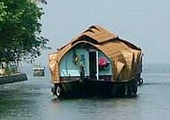
The village of Kumarakom is a cluster of little islands on the Vembanad Lake, and is part of the Kuttanad region. The bird sanctuary here, which is spread across 14 acres is a favourite haunt of migratory birds and an ornithologist's paradise.
Location: 16 km away from Kottayam town, Central Kerala.
The village of Kumarakom is a cluster of little islands on the Vembanad Lake, and is part of the Kuttanad region. The bird sanctuary here, which is spread across 14 acres is a favourite haunt of migratory birds and an ornithologist's paradise. Egrets, darters, herons, teals, waterfowls, cuckoo, wild duck and migratory birds like the Siberian Stork visit here in flocks and are a fascinate the visitors. An enchanting backwater destination, Kumarakom offers visitors many other leisure options. Boating and fishing facilities are available at all resort and house boat. Holiday packages involving houseboats, traditional Kettuvalloms (rice barges) offer great experiences.
Every year, more than seven million tourists visit Kerala, a place that the National Geographic Magazine has described as one of the must-see places in a lifetime. Kumarakom is an important stopover for a majority of these tourists. This famous tourist backwater hub is a cluster of islands on the eastern banks of Lake Vembanad. Compared to adjacent villages, the lake has its maximum length and breadth near Kumarakom - about eight km. With the huge lake on one side and with a network of calm canals running through it, Kumarakom, a masterpiece created by man and Nature together, enjoys a unique position on the map of Kerala.
Getting there:
Nearest railway station: Kottayam, about 16 km.
Nearest airport: Cochin International Airport, about 76 km from Kottayam town.
Munnar

It is one of the attractions that contributed to Kerala's popularity as a travel destination among domestic and foreign travellers.
Situated at the confluence of three mountain streams - Muthirapuzha, Nallathanni and Kundala, and perched about 1600 m above sea level, the hill station of Munnar once used to be the summer resort of the erstwhile British administration in south India. This hill station is marked by vast expanses of tea plantations, colonial bungalows, rivulets, waterfalls and cool weather. It is also an ideal destination for trekking and mountain biking.
Let us now explore some of the options in and around Munnar that would provide travellers ample opportunities to enjoy the captivating hill station of Munnar.
Eravikulam National Park
One of the main attractions near Munnar is the Eravikulam National Park. Located about 15 km from Munnar, this park is famous for its endangered inhabitant - the Nilgiri Tahr. Spread over an area of 97 sq. km., this park is also home to several species of rare butterflies, animals and birds. A great place for trekking, the park offers a magnificent view of the tea plantations and also the rolling hills caressed by blankets of mists. The park becomes a hot destination when the hill slopes here get covered in a carpet of blue, resulting from the flowering of Neelakurinji. It is a plant endemic to this part of the Western Ghats which blooms once in twelve years. The last time it bloomed was in 2006.
Anamudi Peak
Located inside the Eravikulam National Park is the Anamudi Peak. This is the highest peak in south India standing at a height of over 2700 m. Treks to the peak are allowed with permission from the Forest and Wildlife authorities at Eravikulam.
Mattupetty
Another place of interest, located about 13 km from Munnar Town, is Mattupetty. Situated at a height of 1700 m above sea level, Mattupetty is known for its storage masonry dam and the beautiful lake, which offers pleasurable boat rides, enabling one to enjoy the surrounding hills and landscape. Mattupetty's fame is also attributed to the dairy farm run by the Indo-Swiss Livestock Project, where one would come across different high yielding breeds of cows. Mattupetty with its lush green tea plantations, rolling grasslands and the Shola forests is also ideal for trekking and is home to a variety of birds.
Chinnakanal
Near the town of Munnar is Chinnakanal and the waterfalls here, popularly known as Power House Waterfalls, cascade down a steep rock 2000 m above sea level. The spot is enriched with the scenic view of the Western Ghat ranges..
Top Station
Top Station, which is about 32 km from Munnar is at a height of 1700 m above sea level. It is the highest point on the Munnar-Kodaikanal road. Travellers to Munnar make it a point to visit Top Station to enjoy the panoramic view it offers of the neighbouring state of Tamil Nadu. It is one of the spots in Munnar to enjoy the Neelakurinji flowers blooming over a vast area.
Tea Museum
Munnar has a legacy of its own when it comes to the origins and evolution of tea plantations. Taking account of this legacy and to preserve and showcase some of the exquisite and interesting aspects on the genesis and growth of tea plantations in Kerala's high ranges, a museum exclusively for tea was opened some years ago by Tata Tea in Munnar. This Tea Museum houses curios, photographs and machineries; all of which have a story to tell on the origins and growth of tea plantations in Munnar. The museum is located at the Nallathanni Estate of Tata Tea in Munnar and is worth a visit.
Getting there:
Nearest railway stations: Theni (Tamil Nadu), about 60 km away; Aluva about 110 km away.
Nearest airports: Madurai (Tamil Nadu), about 140 km away; Nedumbassery International Airport, about 125 km away.
Thekkady
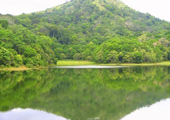
The very sound of the word Thekkady conjures up images of elephants, unending chains of hills and spice scented plantations.
Altitude: 900-1800 m above sea level
Rainfall: 2500 mm
The Periyar forests of Thekkady is one of the finest wildlife reserves in India. Spread across the entire district are picturesque plantations and hill towns that hold great opportunities for treks and mountain walks.
Varkkala
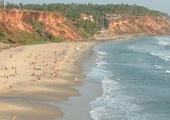
Varkala, a calm and quiet hamlet, lies on the outskirts of Thiruvananthapuram district. It has several places of tourist interests like a beautiful beach, a 2000-year-old Vishnu Temple and the Ashramam - Sivagiri Mutt a little distance from the beach.
Location: 51 km north of Thiruvananthapuram city in Thiruvananthapuram district and 37 km south of Kollam, south Kerala. At the serene Varkala beach is a quiet sea resort rich in mineral water springs. A dip in the holy waters at this beach is believed to purge the body of impurities and the soul of all sins; hence the name 'Papanasam beach'. A two thousand year old shrine the Janardhanaswamy Temple stands on the cliffs overlooking the beach, a short distance away. The Sivagiri Mutt, founded by the great Hindu reformer and philosopher Sree Narayana Guru (1856 - 1928) is also close by. The Samadhi (the final resting place) of the Guru here attracts thousands of devotees every year during the Sivagiri Pilgrimage days - 30th December to 1st January. Sree Narayana Guru propagated the ideology: "one caste, one religion and one god", in a society torn by the taboos of caste system.
Varkala offers excellent accommodation facilities for tourists and is fast becoming a popular health resort with many Ayurvedic massage centres.
Attractions: Beach, mineral water springs, the Sivagiri Mutt and a 2000-year- old Vishnu Temple.
Getting there:
Nearest railway station: Varkala, about 3 km away.
Nearest airport: Thiruvananthapuram International Airport, about 57 km away.
Kovalam

Thiruvananthapuram, the capital city of Kerala, is just 16 km away from Kovalam and getting there is no hassle. But if you are on holiday it is better to stay in Kovalam and visit the city. The City of Thiruvananthapuram has interesting places to see like the Napier Museum, the Sri Chitra Art Gallery, the Padmanabhaswamy Temple, Ponmudi hill station etc. SMSM Institute, a State owned handicrafts emporium, is the ideal place to pick up ethnic curios and other articles.
Location: Just 16 km from Thiruvananthapuram city, South Kerala.
Kovalam is an internationally renowned beach with three adjacent crescent beaches. It has been a favourite haunt of tourists, especially Europeans, since the 1930s. A massive rocky promontory on the beach has created a beautiful bay of calm waters ideal for sea bathing.
The leisure options at this beach are plenty and diverse. Sunbathing, swimming, herbal body toning massages, special cultural programmes and catamaran cruising are some of them. The tropical sun acts so fast that one can see the faint blush of coppery tan on the skin in a matter of minutes. Life on the beach begins late in the day and carries on well into the night. The beach complex includes a string of budget cottages, Ayurvedic health resorts, convention facilities, shopping zones, swimming pools, Yoga and Ayurvedic massage centres.
Best time to visit: September to March, though it is an all-year-round destination.
Getting there:
Nearest railway station: Thiruvananthapuram Central, about 16 km.
Nearest airport: Thiruvananthapuram International Airport, about 10 km.
Wayanad
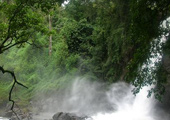
A bio-diverse region spread across 2,132 square kilometers on the lofty Western Ghats, Wayanad is one of the few districts in Kerala that has been able to retain its pristine nature.
Area: 2132 sq. km
Altitude: 700 - 2100 m above sea level
Hidden away in the hills of this land are some of the oldest tribes, as yet untouched by civilization. And the very first prehistoric engravings in Kerala discovered in the foothills of Edakkal and around Ambukuthimala bear testimony to a pre-historic culture dating back to the Mesolithic Age. Strikingly scenic, it is known for its sub-tropical savannahs, picturesque hill stations, sprawling spice plantations, luxuriant forests and rich cultural traditions. A holistic confluence of wilderness, history and culture, Wayanad is located on the southern tip of the magnificent Deccan plateau.
Air:
Nearest airport: Kozhikode
Rail:
Nearest railway station: Kozhikode Major towns in the district and distance from the nearest railway station: Kalpetta: 72 km from Kozhikode, Mananthavady: 80 km from Thalassery and 106 km from Kozhikode, Sulthan Bathery: 97 km from Kozhikode, Vythiri: 60 km from Kozhikode.
Road:
Well connected by roads from Kozhikode, Kannur, Ooty (175 km from Kalpetta) and Mysore (140 km from Kalpetta).
MUST SEE
Chembra Peak, Kuruvadweep, Vythiri Hill Station, Banasura Sagar Dam, Edakkal Caves
Bekal
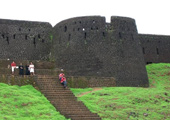
Kasaragod, the Northern most district of Kerala is renowned as the land of gods, forts, rivers, hills and beautiful beaches. The imposing fort at Bekal is one of the largest and best preserved forts in Kerala. The beautiful expanse of the shallow beach near the Bekal fort known as Bekal Fort Beach has been developed as an exotic beach location by the Bekal Resorts Development Corporation (BRDC).
Location: About 16 km South of Kasaragod on the national highway, Kasaragod district, North Kerala
Beautification: Beautification of the site includes installation of two sculptures of Theyyam created using laterite on the beach and a shed the walls of which are adorned with murals created by artisans from Nilambur. Apart from these a rock garden at the parking area has been developed where laterite boulders of various sizes have been utilised. Under the social forestry scheme, trees have been planted in the beach area.
Parking facilities: The BRDC has developed about 7000 sq. m of land for parking different types of vehicles.
Walkway: A beautiful walkway has been laid for the visiting tourists to explore the beauty of the fine coastline and enjoy the panoramic view of the Bekal Fort.
Illuminated beach: The beach gets illuminated during the evening hours so that tourists can spend more time at the beach even after the sun sets. Resting facilities: Multi shed and Eru madam (Tree house) would provide the tourists enough facilities to take rest and enjoy the sea breeze. By using locally available materials seating arrangements have been provided for the tourists at the beach. Toilets: Toilets have been provided for the use of tourists and eco-friendly bamboo waste bins have been provided in the entire beach site for keeping the area clean.
Children's park: A park has been developed here for children below 14 years.
In order to maintain the developed site a nominal charge of one rupee from each visitor would be collected as entry fees. A similar nominal vehicle parking fees would also be collected. The BRDC also aims to develop in future another 11 acres of land at the beach for constructing water park, theme park etc. The BRDC was set up by the Government of Kerala to develop Bekal as a planned eco-friendly destination. The BRDC has utilised 19 acres of land for the development of the Bekal Fort Beach at a cost of approximately Rs. 25 million including land acquisition charges.
Getting there:
Nearest railway station: Kasaragod, on the Kozhikode-Mangalore-Mumbai route.
Nearest airport: Mangalore, about 50 km from Kasaragod town; Karipur International Airport, Kozhikode, about 200 km from Kasaragod town.
Athirapally
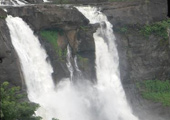
Athirappalli and Vazhachal, the two scenic and popular waterfalls on the edge of the Sholayar forest ranges are just 5 km apart. The Athirappalli Falls joins the Chalakkudy river after plummeting down a drop of 80 feet. Vazhachal is part of the Chalakkudy river. Both the waterfalls, their cool, misty waters cascading down in the backdrop of thick green forest and rocky terrain, are a scintillating experience to visitors.
Location: Athirappalli 63 km from Thrissur and Vazhachal 68 km from Thrissur.
Getting there:
A good motorable road takes you to Vazhachal and Athirappalli from either Kochi or Thrissur town.
Nearest railway station: Chalakudy, about 30 km away.
Nearest airport: Cochin International Airport, about 58 km from Thrissur.
